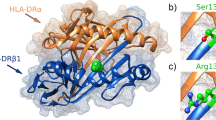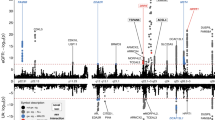Abstract
Semen quality is affected by environmental factors, endocrine function abnormalities, and genetic factors. A GWAS recently identified ERBB4 at 2q34 as a genetic locus associated with sperm motility. However, GWASs for human semen volume and sperm concentration have not been conducted. In addition, testis size also reportedly correlates with semen quality, and it is important to identify genes that affect testis size. Reproductive hormones also play an important role in spermatogenesis. To date, genetic loci associated with plasma testosterone, sex hormone-binding globulin (SHBG), follicle-stimulating hormone (FSH), and luteinizing hormone (LH) levels have been identified using GWASs. However, GWASs have not identified any relevant loci for plasma inhibin B levels. We conducted a two-stage GWAS using 811 Japanese men in a discovery stage followed by a replication stage using an additional 721 Japanese men. The results of the discovery and replication stages were combined into a meta-analysis. After setting a suggestive significance threshold for P values < 5 × 10−6 in the discovery stage, we identified ten regions with SNPs (semen volume: one, sperm concentration: three, testes size: two, and inhibin B: four). We selected only the most significant SNP in each region for replication genotyping. Combined discovery and replication results in the meta-analysis showed that the locus 12q21.31 associated with plasma inhibin B levels (rs11116724) had the most significant association (P = 5.7 × 10−8). The LRRIQ1 and TSPAN19 genes are located in the 12q21.31 region. This study provides new susceptibility variants that contribute to plasma inhibin B levels.
This is a preview of subscription content, access via your institution
Access options
Subscribe to this journal
Receive 12 print issues and online access
$259.00 per year
only $21.58 per issue
Buy this article
- Purchase on Springer Link
- Instant access to full article PDF
Prices may be subject to local taxes which are calculated during checkout


Similar content being viewed by others

References
World Health Organization Department of Reproductive Health and Research. WHO laboratory manual for the examination and processing of human semen, 5th edn. World Health Organization, 2010.
Zhang J, Ding X, Li Y, Xia Y, Nie J, Yi C, et al. Association of CLOCK gene variants with semen quality in idiopathic infertile Han-Chinese males. Reprod Biomed Online. 2012;25:536–42.
Zhao D, Wu W, Xu B, Niu X, Cui H, Zhang Y, et al. Variants in the SRD5A2 gene are associated with quality of semen. Mol Med Rep. 2012;6:639–44.
Tüttelmann F, Krenková P, Römer S, Nestorovic AR, Ljujic M, Stambergová A, et al. A common haplotype of protamine 1 and 2 genes is associated with higher sperm counts. Int J Androl. 2010;33:e240–8.
Teng YN, Chang YP, Tseng JT, Kuo PH, Lee IW, Lee MS, et al. A single-nucleotide polymorphism of the DAZL gene promoter confers susceptibility to spermatogenic failure in the Taiwanese Han. Hum Reprod. 2012;27:2857–65.
Sato Y, Tajima A, Katsurayama M, Nozawa S, Yoshiike M, Koh E, et al. A replication study of a candidate locus for follicle-stimulating hormone levels and association analysis for semen quality traits in Japanese men. J Hum Genet. 2016;61:911–5.
Lindgren KE, Nordqvist S, Kårehed K, Sundström-Poromaa I, Åkerud H. The effect of a specific histidine-rich glycoprotein polymorphism on male infertility and semen parameters. Reprod Biomed Online. 2016;33:180–8.
Pan L, Liu Q, Li J, Wu W, Wang X, Zhao D, et al. Association of the VDAC3 gene polymorphism with sperm count in Han-Chinese population with idiopathic male infertility. Oncotarget. 2017;8:45242–8.
Sato Y, Tajima A, Sato T, Nozawa S, Yoshiike M, Imoto I, et al. Genome-wide association study identifies ERBB4 on 2q34 as a novel locus associated with sperm motility in Japanese men. J Med Genet. 2018;55:415–21.
Sakamoto H, Yajima T, Nagata M, Okumura T, Suzuki K, Ogawa Y. Relationship between testicular size by ultrasonography and testicular function: measurement of testicular length, width, and depth in patients with infertility. Int J Urol. 2008;15:529–33.
Belchetz PE, Plant TM, Nakai EJ, Knobil E. Hypophysial responses to continuous and intermittent delivery of hypopthalamic gonadotropin-releasing hormone. Science. 1978;202:631–3.
Smith MA, Vale WW. Desensitization to gonadotropin-releasing hormone observed in superfused pituitary cells on Cytodex beads. Endocrinology. 1981;108:752–9.
Kaufman JM, Vermeulen A. The decline of androgen levels in elderly men and its clinical and therapeutic implications. Endocr Rev. 2005;26:833–76.
McLachlan RI, O’Donnell L, Meachem. SJ, Stanton PG, De Kretser DM, Pratis K, et al. Identification of specific sites of hormonal regulation in spermatogenesis in rats, monkeys and man. Recent Prog Horm Res. 2002;57:149–79.
Schlatt S, Ehmcke J. Regulation of spermatogenesis: an evolutionary biologist’s perspective. Semin Cell Dev Biol. 2014;29C:2–16.
Kuijper EA, Lambalk CB, Boomsma DI, van der Sluis S, Blankenstein MA, de Geus EJ, et al. Heritability of reproductive hormones in adult male twins. Hum Reprod. 2007;22:2153–9.
Ohlsson C, Wallaschofski H, Lunetta KL, Stolk L, Perry JR, Koster A, et al. Genetic determinants of serum testosterone concentrations in men. PLoS Genet. 2011;7:e1002313.
Jin G, Sun J, Kim ST, Feng J, Wang Z, Tao S, et al. Genome-wide association study identifies a new locus JMJD1C at 10q21 that may influence serum androgen levels in men. Hum Mol Genet. 2012;21:5222–8.
Chen Z, Tao S, Gao Y, Zhang J, Hu Y, Mo L, et al. Genome-wide association study of sex hormones, gonadotropins and sex hormone-binding protein in Chinese men. J Med Genet. 2013;50:794–801.
Coviello AD, Haring R, Wellons M, Vaidya D, Lehtimäki T, Keildson S, et al. A genome-wide association meta-analysis of circulating sex hormone-binding globulin reveals multiple Loci implicated in sex steroid hormone regulation. PLoS Genet. 2012;8:e1002805.
Ruth KS, Campbell PJ, Chew S, Lim EM, Hadlow N, Stuckey BG, et al. Genome-wide association study with 1000 genomes imputation identifies signals for nine sex hormone-related phenotypes. Eur J Hum Genet. 2016;24:284–90.
Iwamoto T, Nozawa S, Mieno MN, Yamakawa K, Baba K, Yoshiike M, et al. Semen quality of 1559 young men from four cities in Japan: a cross-sectional population-based study. BMJ Open. 2013;3:e002222.
Iwamoto T, Nozawa S, Yoshiike M, Namiki M, Koh E, Kanaya J, et al. Semen quality of fertile Japanese men: a cross-sectional population-based study of 792 men. BMJ Open. 2013;3:e002223.
Purcell S, Neale B, Todd-Brown K, Thomas L, Ferreira MA, Bender D, et al. PLINK: a tool set for whole-genome association and population-based linkage analyses. Am J Hum Genet. 2007;81:559–75.
Browning SR, Browning BL. Rapid and accurate haplotype phasing and missing data inference for whole genome association studies by use of localized haplotype clustering. Am J Hum Genet. 2007;81:1084–97.
Browning BL, Browning SR. Genotype imputation with millions of reference samples. Am J Hum Genet. 2016;98:116–26.
The 1000 Genomes Project Consortium. A global reference for human genetic variation. Nature. 2015;526:68–74.
The 1000 Genomes Project Consortium. An integrated map of structural variation in 2,504 human genomes. Nature. 2015;526:75–81.
Higgins JP, Thompson SG, Deeks JJ, Altman DG. Measuring inconsistency in meta-analyses. BMJ. 2003;327:557–60.
Pruim RJ, Welch RP, Sanna S, Teslovich TM, Chines PS, Gliedt TP, et al. LocusZoom: regional visualization of genome-wide association scan results. Bioinformatics. 2010;26:2336–7.
Ward LD, Kellis M. HaploReg: a resource for exploring chromatin states, conservation, and regulatory motif alterations within sets of genetically linked variants. Nucleic Acids Res. 2012;40:D930–4.
GTEx Consortium. The genotype-tissue expression (GTEx) project. Nat Genet. 2013;45:580–5.
Ng PC, Henikoff S. SIFT: Predicting amino acid changes that affect protein function. Nucleic Acids Res. 2003;31:3812–4.
Adzhubei I, Jordan DM, Sunyaev SR. Predicting functional effect of human missense mutations using PolyPhen‐2. Curr Protoc Hum Genet. 2013;chapter7:unit7.20. https://doi.org/10.1002/0471142905.hg0720s76.
Huttlin EL, Bruckner RJ, Paulo JA, Cannon JR, Ting L, Baltier K, et al. Architecture of the human interactome defines protein communities and disease networks. Nature. 2017;545:505–9.
Mathews LS, Vale WW. Expression cloning of an activin receptor, a predicted transmembrane serine kinase. Cell. 1991;65:973–2.
Lewis KA, Gray PC, Blount AL, MacConell LA, Wiater E, Bilezikjian LM, et al. Betaglycan binds inhibin and can mediate functional antagonism of activin signaling. Nature. 2000;404:411–4.
Acknowledgements
We are grateful to the late Prof. Yutaka Nakahori and Profs. Eitetsue Koh, Jiro Kanaya, Mikio Namiki, Kiyomi Matsumiya, Akira Tsujimura, Kiyoshi Komatsu, Naoki Itoh, and Jiro Eguchi for collecting blood samples from participants. We also thank Prof. Toyomasa Katagiri for his assistance with the AB GeneAmp PCR system 9700. This study was supported in part by the Ministry of Health and Welfare of Japan (1013201) (to TI), Grant-in-Aids for Scientific Research (C) (26462461) (to YS), (23510242) (to AT), and Grant-in-Aids for Scientific Research (B) (17H04331) (to YS), (15H04320) (to AT) from the Japan Society for the Promotion of Science, and the European Union (BMH4-CT96-0314) (to TI). We would like to thank Editage (www.editage.com) for English language editing.
Author information
Authors and Affiliations
Corresponding authors
Ethics declarations
Conflict of interest
The authors declare that they have no conflict of interest.
Additional information
Publisher’s note Springer Nature remains neutral with regard to jurisdictional claims in published maps and institutional affiliations.
Rights and permissions
About this article
Cite this article
Sato, Y., Tajima, A., Kiguchi, M. et al. Genome-wide association study of semen volume, sperm concentration, testis size, and plasma inhibin B levels. J Hum Genet 65, 683–691 (2020). https://doi.org/10.1038/s10038-020-0757-3
Received:
Revised:
Accepted:
Published:
Issue Date:
DOI: https://doi.org/10.1038/s10038-020-0757-3
This article is cited by
-
Lrriq1 is an essential factor for fertility by suppressing apoptosis
Journal of Assisted Reproduction and Genetics (2022)


